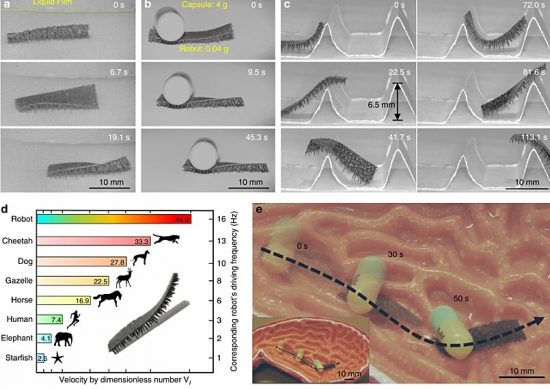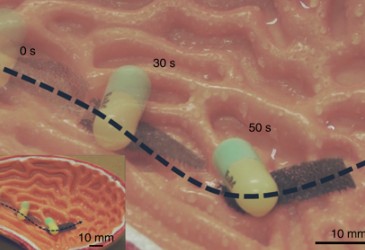November 10, 2018 – When you think of robots you think of a mechanical device with articulated joints, powered by an onboard computer processor. But robots have an entirely different appearance these days. For example, a Roomba bears a resemblance to a Horseshoe Crab. The general shape is different. The crab is more an oblong oval shape while the Roomba is round. But both move in a scurrying like manner. And you really have trouble discerning where there is a head. The crab at least gives you a hint because of its tail.
The latest robot that bears no resemblance to our gestalt perception is a tiny robot that is soft and moves around like a caterpillar on multiple legs. Made of a highly flexible, soft silicon material called polydimethylsiloxane (PDMS), it has hundreds of tiny and legs and is embedded with magnetic particles which when in the presence of electromagnetic force combine to create motion. If cut in half it becomes two robots. Cut in three and voila you have three.
Its inventors are researchers at City University of Hong Kong. They have designed the robot to be a mini delivery vehicle. And its purpose is to carry payloads through the human body such as medicines which then can be delivered to specific organs. An article describing the robot can be read in a recent issue of Nature Communications.
Referred to as a millibot in the article, it is described as being adaptable to harsh environments, capable of ultrafast locomotion, and has a carrying capacity exceeding 100 times its own weight. With a height of approximately 1 millimeter (0.0393701 inches) and tapered feet that can handle almost any obstacle, the millibot works in wet or dry conditions and can scale steep slopes while maintaining surface contact.
It features two ways of movement: one is a wave-like flapping motion, while the other is continuous locomotion that resembles the way a human walks with its many legs synchronously rising and falling to propel it forward.
The soft feet, as they move, store and release energy continuously to affect locomotion. The external electromagnetic force can move the robot to the left, or right, or forward. It can manage slippery surfaces, heavy loads, and high obstacles with slope angles of 60 degrees. It can even raise its body to a 90-degree angle to navigate obstacles 10 times the height of its feet. And because the material is superhydrophobic friction is reduced between it and the surface it is walking on.









